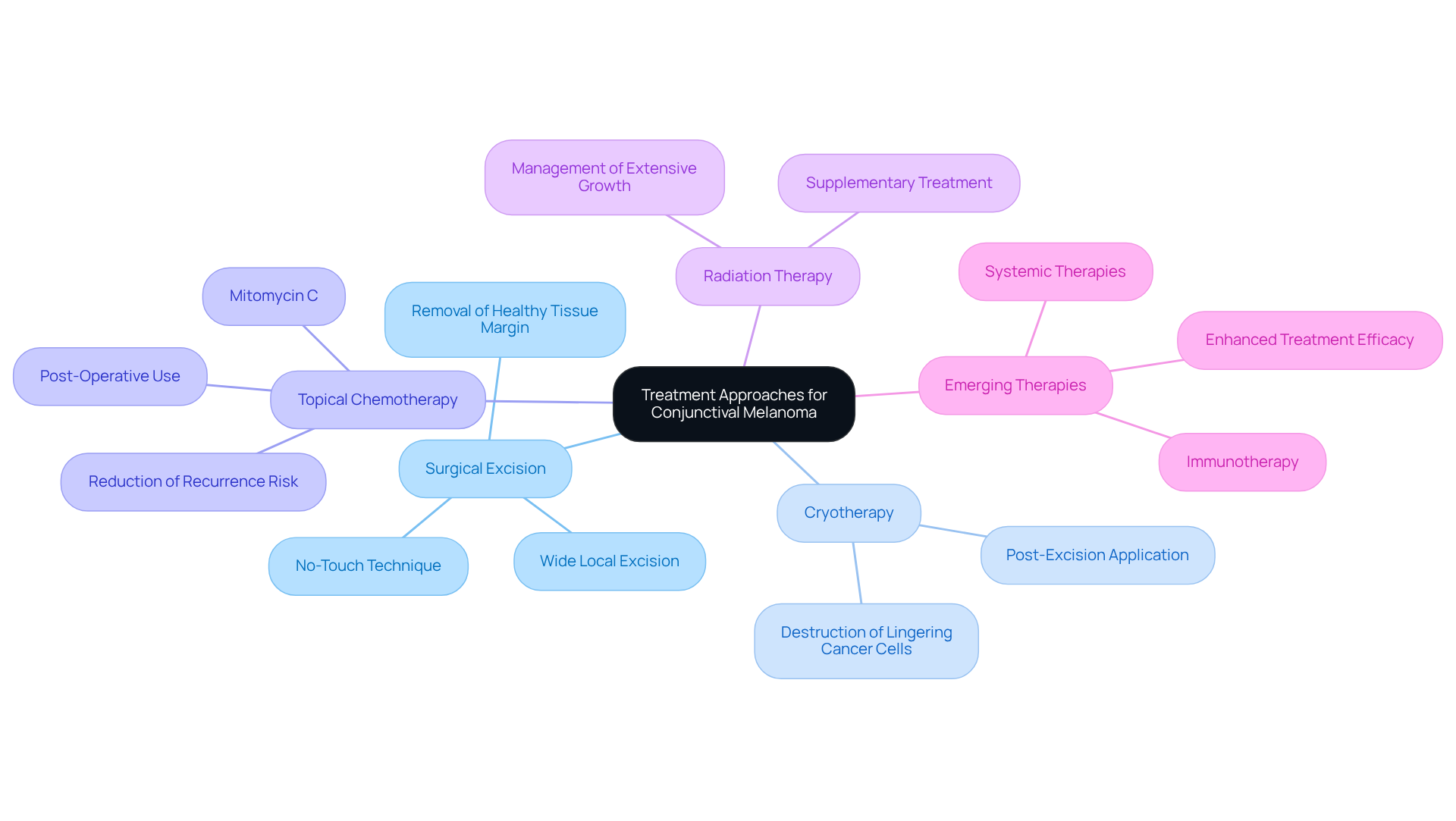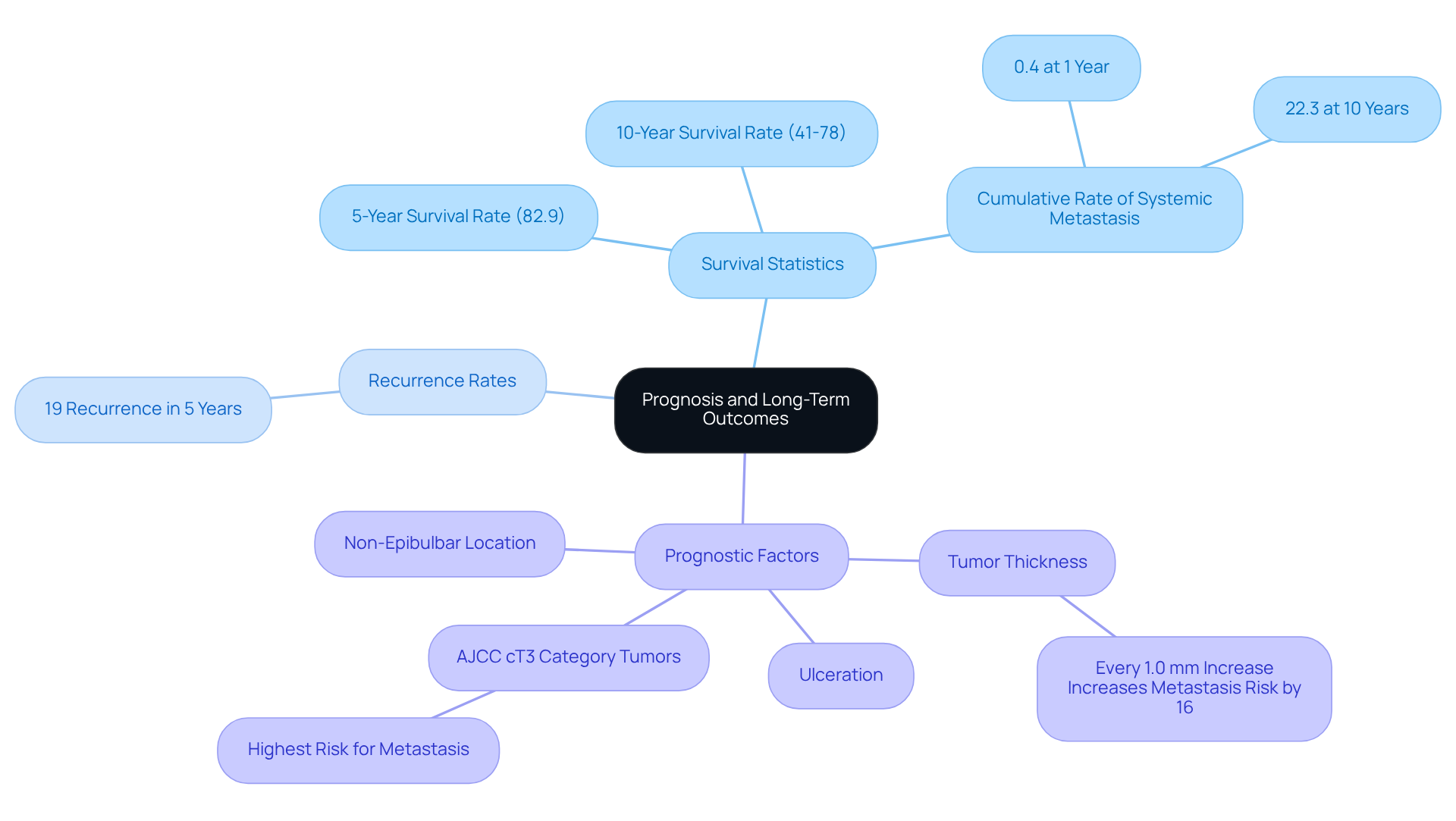Posted by: Northwest Eye in General on November 25, 2025
Introduction
Conjunctival melanoma is a rare but serious eye tumor that can often be overlooked. We understand that learning about this condition can be overwhelming, especially for those who may be affected. Primarily impacting fair-skinned individuals, the need for timely diagnosis and treatment is crucial.
In this article, we will explore the complexities of conjunctival melanoma, including its diagnostic process, treatment options, and long-term prognosis. It’s common to feel uncertain about what lies ahead, but rest assured, we are here to help you through this process.
Navigating the uncertainties of conjunctival melanoma can be challenging, but understanding your options is the first step towards ensuring the best possible outcomes for your eye health. Together, we can address your concerns and provide the support you need.
Overview of Conjunctival Melanoma
Conjunctival melanoma is an uncommon yet fierce type of eye malignancy that originates from the melanocytes in the conjunctiva, the clear tissue covering the white part of the eye. We understand that hearing about cancer can be overwhelming, and it’s common to feel anxious about what this means for you or your loved ones. Conjunctival melanoma accounts for roughly 2-5% of all ocular tumors, with an incidence rate of 0.2 to 0.8 cases per million people each year, primarily impacting fair-skinned individuals.
CoC, also known as conjunctival melanoma, can present as a pigmented or non-pigmented lesion, and it’s often mistaken for benign conditions. This can lead to delayed diagnosis, which is understandably concerning. It’s important to recognize that early detection and intervention are crucial for improving patient outcomes. We are here to help you through this process, providing the support and information you need.
If you or someone you know is experiencing symptoms, please don’t hesitate to seek medical advice. Remember, you are not alone in this journey, and there are resources available to guide you.

Diagnosis of Conjunctival Melanoma
Identifying conjunctival melanoma on the eye’s surface can be a daunting experience, but understanding the process can help alleviate your concerns. It all begins with a thorough eye assessment performed by an ophthalmologist or ocular oncologist. Here are the key steps involved:
-
Clinical Examination: A meticulous assessment of the conjunctival surface is performed, focusing on identifying lesions that may appear as brown or pink spots. We understand that noticing changes can be unsettling, but this examination is crucial for your health.
-
Slit Lamp Biomicroscopy: This technique provides detailed visualization of the conjunctiva, allowing for a closer look at the lesion’s extent and characteristics. Many patients find comfort in knowing that this method can reveal subtle lesions that might otherwise go unnoticed.
-
Imaging Techniques: Advanced imaging modalities, such as ultrasound and optical coherence tomography (OCT), are employed to assess the mass’s thickness and depth. These tools enhance diagnostic accuracy, giving you peace of mind.
-
Biopsy: An excisional biopsy is the preferred method for obtaining a definitive diagnosis. This approach allows for thorough histopathological examination while minimizing the risk of tumor seeding. Timely biopsy can significantly enhance surgical success rates and reduce the chances of local recurrence and metastasis.
We understand that early identification is crucial in managing conjunctival melanoma effectively. Delays in the diagnosis of conjunctival melanoma can lead to deeper tissue invasion and systemic spread, which is why it’s essential to remain vigilant. Risk factors such as excessive UV light exposure and being middle-aged further highlight the importance of monitoring your eye health.
As experts emphasize, “Timely diagnosis remains paramount: recognizing and biopsying suspicious eye lesions within weeks rather than months significantly enhances surgical success rates and reduces the likelihood of local recurrence and metastatic dissemination.” Additionally, structured postoperative monitoring is vital for early detection of recurrence, ensuring comprehensive management of your condition.
Remember, we are here to help you through this process. Your health and well-being are our top priorities.

Treatment Approaches for Conjunctival Melanoma
When it comes to treating conjunctival melanoma, we recognize that the journey can feel overwhelming. The primary approach to managing conjunctival melanoma typically involves surgical intervention, often paired with additional therapies to ensure the best possible outcome. Here’s a closer look at the main treatment options:
-
Surgical Excision: This is the standard method, where a wide local excision is performed using a ‘no-touch technique.’ This careful approach helps minimize the risk of cancer cell seeding. The procedure involves the meticulous removal of the growth along with a margin of healthy tissue, ensuring thorough treatment.
-
Cryotherapy: After the excision, cryotherapy may be applied to the edges of the removed mass. This technique is designed to destroy any lingering cancer cells, including those related to conjunctival melanoma, providing an extra layer of protection.
-
Topical chemotherapy, including agents like mitomycin C, can be utilized post-operatively to further reduce the chances of recurrence in patients with conjunctival melanoma. This step can offer peace of mind as you move forward in your recovery.
-
Radiation Therapy: In cases where the growth is extensive or has returned, radiation therapy may be recommended as a supplementary treatment. This option can be crucial in managing the condition effectively.
-
Emerging Therapies: We are excited about new systemic therapies, including immunotherapy, which are currently being explored. These advancements aim to enhance treatment efficacy and may reduce the need for extensive surgical procedures.
We are here to help you through this process, and it’s common to feel a mix of emotions as you navigate your treatment options. Remember, you’re not alone in this journey.

Prognosis and Long-Term Outcomes
The outlook for individuals facing eye surface cancer can vary significantly, and we understand that this can be a challenging time. Factors such as tumor size, location, and histological characteristics play a crucial role in determining individual outcomes. Here are some key points to consider:
-
Survival Statistics: It’s reassuring to know that the 5-year survival rate for conjunctival melanoma is around 82.9%. However, the 10-year survival rate can range from 41% to 78%, depending on various factors. It’s important to note that the cumulative rate of systemic metastasis increases from 0.4% at 1 year to 22.3% at 10 years, which highlights the need for long-term monitoring and care.
-
Recurrence Rates: We recognize that the possibility of local recurrence can be concerning, as it occurs in about 19% of patients within five years. This underscores the importance of regular follow-up appointments to ensure your health is closely monitored.
-
Prognostic Factors: Certain elements, such as the thickness of the neoplasm, ulceration, and non-epibulbar location, are associated with worse outcomes. According to the AJCC staging system, cT3 category tumors are at the highest risk for metastasis. We recommend regular monitoring by experienced ocular oncologists to detect any recurrence early and manage it effectively.
Additionally, it’s essential to acknowledge the mental health challenges that patients may face during their cancer journey. These struggles can significantly impact overall well-being, and seeking support is vital. Remember, we are here to help you through this process.

Conclusion
Conjunctival melanoma, while rare, can be daunting. We understand that facing such a diagnosis brings a whirlwind of emotions and concerns. This article highlights the critical importance of early detection, which can significantly influence patient outcomes. By recognizing symptoms and seeking timely medical intervention, you can enhance your chances of successful treatment and recovery.
The diagnostic process is vital. It includes:
- Clinical examinations
- Advanced imaging techniques
- Biopsies
All essential for accurately identifying this malignancy. We know it can feel overwhelming, but understanding these steps can help ease your worries. The treatment landscape is diverse, ranging from surgical excision to emerging therapies, emphasizing the need for tailored care based on your unique circumstances.
Understanding prognosis and long-term outcomes, including survival rates and recurrence risks, is crucial for managing expectations. It’s common to feel uncertain about what lies ahead, but being informed can empower you in your journey.
Ultimately, awareness and vigilance are key in navigating the complexities of conjunctival melanoma. For those affected, seeking regular follow-up care and support can make a significant difference in managing this condition. Remember, prioritizing your eye health and engaging with healthcare professionals can lead to better outcomes and an improved quality of life. We are here to help you through this process.
Frequently Asked Questions
What is conjunctival melanoma?
Conjunctival melanoma is a rare and aggressive type of eye cancer that originates from the melanocytes in the conjunctiva, the clear tissue covering the white part of the eye.
How common is conjunctival melanoma?
Conjunctival melanoma accounts for approximately 2-5% of all ocular tumors, with an incidence rate of 0.2 to 0.8 cases per million people each year, primarily affecting fair-skinned individuals.
What are the characteristics of conjunctival melanoma?
Conjunctival melanoma can present as either a pigmented or non-pigmented lesion and is often mistaken for benign conditions, which can lead to delayed diagnosis.
Why is early detection important in conjunctival melanoma?
Early detection and intervention are crucial for improving patient outcomes in conjunctival melanoma.
What should someone do if they experience symptoms of conjunctival melanoma?
If you or someone you know is experiencing symptoms, it is important to seek medical advice promptly.






